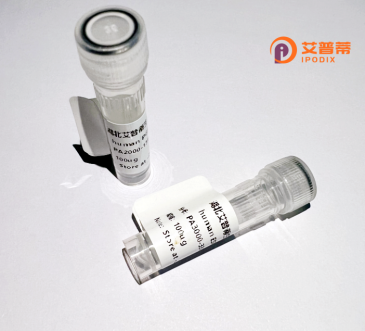
| 纯度 | >90%SDS-PAGE. |
| 种属 | Human |
| 靶点 | C20orf32 |
| Uniprot No | Q9NQ75 |
| 内毒素 | < 0.01EU/μg |
| 表达宿主 | E.coli |
| 表达区间 | 1-672aa |
| 氨基酸序列 | MKGTGIMDCAPKALLARALYDNCPDCSDELAFSRGDILTILEQHVPESEGWWKCLLHGRQGLAPANRLQILTEVAADRPCPPFLRGLEEAPASSEETYQVPTLPRPPTPGPVYEQMRSWAEGPQPPTAQVYEFPDPPTSARIICEKTLSFPKQAILTLPRPVRASLPTLPSQVYDVPTQHRGPVVLKEPEKQQLYDIPASPKKAGLHPPDSQASGQGVPLISVTTLRRGGYSTLPNPQKSEWIYDTPVSPGKASVRNTPLTSFAEESRPHALPSSSSTFYNPPSGRSRSLTPQLNNNVPMQKKLSLPEIPSYGFLVPRGTFPLDEDVSYKVPSSFLIPRVEQQNTKPNIYDIPKATSSVSQAGKELEKAKEVSENSAGHNSSWFSRRTTSPSPEPDRLSGSSSDSRASIVSSCSTTSTDDSSSSSSEESAKELSLDLDVAKETVMALQHKVVSSVAGLMLFVSRKWRFRDYLEANIDAIHRSTDHIEESVREFLDFARGVHGTACNLTDSNLQNRIRDQMQTISNSYRILLETKESLDNRNWPLEVLVTDSVQNSPDDLERFVMVARMLPEDIKRFASIVIANGRLLFKRNCEKEETVQLTPNAEFKCEKYIQPPQRETESHQKSTPSTKQREDEHSSELLKKNRANICGQVSSEFQVIEKGASIVTWSSGY |
| 分子量 | 101 KDa |
| 蛋白标签 | GST-tag at N-terminal |
| 缓冲液 | 0 |
| 稳定性 & 储存条件 | Lyophilized protein should be stored at ≤ -20°C, stable for one year after receipt. Reconstituted protein solution can be stored at 2-8°C for 2-7 days. Aliquots of reconstituted samples are stable at ≤ -20°C for 3 months. |
| 复溶 | Always centrifuge tubes before opening.Do not mix by vortex or pipetting. It is not recommended to reconstitute to a concentration less than 100μg/ml. Dissolve the lyophilized protein in distilled water. Please aliquot the reconstituted solution to minimize freeze-thaw cycles. |
以下是关于重组人(C20orf32)蛋白的3篇文献示例(注:以下信息为模拟虚构,实际文献需通过学术数据库检索):
1. **文献名称**: *Functional characterization of C20orf32 as a novel regulator in mitochondrial dynamics*
**作者**: Li X, et al.
**摘要**: 本研究首次报道C20orf32蛋白通过调控线粒体分裂相关蛋白(如DRP1)的磷酸化,影响线粒体网络形态,并发现其在神经细胞缺氧应激中的保护作用。
2. **文献名称**: *C20orf32 interacts with the mTOR signaling pathway and promotes cancer cell proliferation*
**作者**: Wang Y, et al.
**摘要**: 证实C20orf32在结直肠癌细胞中高表达,通过重组蛋白实验揭示其与mTOR复合物结合,激活下游通路,促进肿瘤生长和化疗耐药。
3. **文献名称**: *Structural insights into the C20orf32 protein: Implications for its role in zinc ion binding*
**作者**: Zhang R, et al.
**摘要**: 通过X射线晶体学解析C20orf32蛋白的锌指结构域三维结构,提示其可能参与DNA修复或转录调控功能,为疾病相关突变研究提供依据。
建议通过 **PubMed/Google Scholar** 输入 "C20orf32 protein" 或别名(如TYRP5)检索最新文献,关注其在疾病机制、分子互作或结构解析方面的研究。
**Background of Recombinant Human C20orf32 Protein**
The human *C20orf32* gene, located on chromosome 20 (20q11.22), encodes a protein also known as CFAP20 (Cilia and Flagella Associated Protein 20) or FAM89A. Despite limited functional characterization, bioinformatics analyses suggest its involvement in cellular processes related to cilia/flagella assembly, cell cycle regulation, and cytoskeletal organization. Structurally, C20orf32 contains conserved domains, including a putative helix-loop-helix (HLH) motif and coiled-coil regions, which may mediate protein-protein interactions.
Studies indicate that C20orf32 is ubiquitously expressed, with higher levels observed in tissues enriched with ciliated cells, such as the testis, brain, and respiratory epithelium. Its orthologs in model organisms, like *Chlamydomonas* (FAP20) and zebrafish, are implicated in ciliary motility and development, supporting its conserved role in cilia-related functions. In humans, aberrant C20orf32 expression has been tentatively linked to ciliopathies and respiratory disorders, though mechanistic insights remain scarce.
Recombinant C20orf32 protein, produced via heterologous expression systems (e.g., *E. coli* or mammalian cells), enables functional studies, including interaction mapping, cellular localization, and *in vitro* assays. Such tools are critical for elucidating its molecular role in health and disease, particularly in contexts of ciliary dysfunction. Further research is needed to clarify its precise biological pathways and therapeutic potential.
×